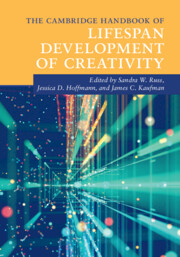Book contents
- The Cambridge Handbook of Lifespan Development of Creativity
- The Cambridge Handbook of Lifespan Development of Creativity
- Copyright page
- Dedication
- Contents
- Figures
- Tables
- Contributors
- Acknowledgments
- Introduction
- Part I Core Concepts of Lifespan Creativity Development
- Part II The Development of Creativity
- Part III Modes of Enhancement
- Part IV Environments and Contexts
- 18 Creative Identity Development in Classrooms
- 19 Creativity in Children’s Museums
- 20 Makers and Makerspaces
- 21 Organizations and Creativity
- 22 Creativity Development and Culture
- Part V Special Populations
- Index
- References
21 - Organizations and Creativity
from Part IV - Environments and Contexts
Published online by Cambridge University Press: 19 November 2021
- The Cambridge Handbook of Lifespan Development of Creativity
- The Cambridge Handbook of Lifespan Development of Creativity
- Copyright page
- Dedication
- Contents
- Figures
- Tables
- Contributors
- Acknowledgments
- Introduction
- Part I Core Concepts of Lifespan Creativity Development
- Part II The Development of Creativity
- Part III Modes of Enhancement
- Part IV Environments and Contexts
- 18 Creative Identity Development in Classrooms
- 19 Creativity in Children’s Museums
- 20 Makers and Makerspaces
- 21 Organizations and Creativity
- 22 Creativity Development and Culture
- Part V Special Populations
- Index
- References
Summary
Creativity and innovation are important for organizational survival and growth, as globalization and technological advances increase the need to address rapid changes and uncertainty in the marketplace. As such, organizations and researchers have produced a significant amount of work on creativity and innovation to help address organizations’ need to develop creative ideas and solutions. These studies have yielded a variety of findings, sometimes contradictory, since organizational creativity is a multi-level issue; factors of creativity and innovation at one level may be different, not predictive, or even contradictory at another level. This chapter overviews these findings to summarize the factors in organizations that facilitate or hinder creativity and innovation at each manifested level: the individual, team, and organization. At the individual level, work on creativity and innovation focuses on the creative problem-solving process, personality of creative individuals, and motivational variables. At the team level, creativity and innovation focus on factors within leadership, team processes, and climate. Finally, creativity and innovation at the organizational level are overviewed regarding organizational strategy, goals and rewards, top management teams, and availability of resources.
Keywords
- Type
- Chapter
- Information
- The Cambridge Handbook of Lifespan Development of Creativity , pp. 460 - 479Publisher: Cambridge University PressPrint publication year: 2021



